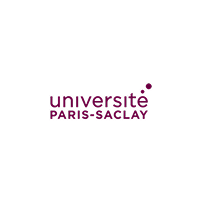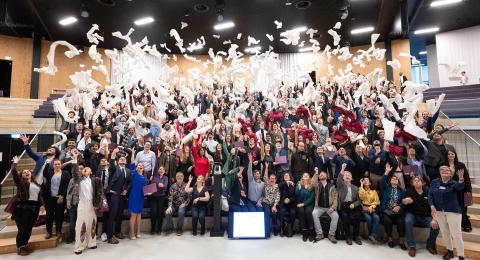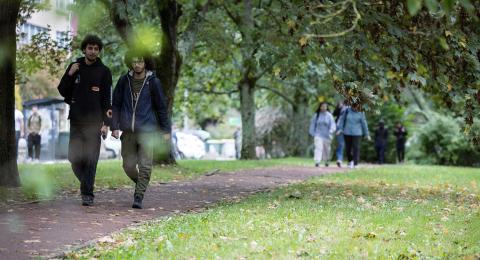The Master's degree in Ergonomics and Human Factors aims to train ergonomists and Human Factors specialists. The first year of the Master's degree focuses on three of the five competencies covered by the full program:
- Understanding human activities in context using a systemic approach.
- Adapting ergonomic practices to societal changes.
- Conducting a reflective analysis of ergonomics, the profession of ergonomist, and one's own practice.
The first semester provides multidisciplinary knowledge and skills to perform an ergonomic analysis of a workstation. The second semester provides additional knowledge and skills aimed at broadening the scope of analysis to perform an ergonomic diagnosis of a work system at the level of a small enterprise.
Information
Skills
The first year of the master's programme aims to teach the skills needed to carry out an ergonomic diagnosis of a work system in a small enterprise. It is structured around three areas of competencies: 1) Understanding human activities in context using a systemic approach. 2) Adapting ergonomic practices to societal changes. 3) Conducting a reflective analysis of ergonomics, the profession of ergonomist, and one's own practice. This structuration is in line with the RNCP (National Register of Professional Certifications) entry for ergonomics: https://www.francecompetences.fr/recherche/rncp/38544/
Objectives
The first semester provides basic theoretical and methodological knowledge on human functioning and work environments from a multidisciplinary perspective (ergonomics, psychology, physiology, physics, neuroanatomy, etc.). The programme is structured around lectures supplemented by tutorials and practical work, which aim to help students develop professional skills from the very first weeks. At the end of the first semester, students must carry out an ergonomic analysis of a workstation in a real work situation in order to produce a diagnosis in terms of health and performance with regard to the human activities associated with that workstation. This exercise aims to integrate all the lessons learned in the first semester in relation to a professional situation relevant to the ergonomist's profession.
The second semester focuses on providing multidisciplinary knowledge (ergonomics, management, design, physiology, statistics, etc.) related to design processes and the functioning of socio-organisational systems. In addition, students must work in pairs to carry out an ergonomic analysis of work in a small enterprise during an internship. Throughout, they are supervised collectively by professionals and researchers in ergonomics. This work results in an academic dissertation and a defence.
Throughout the year, students are taught about the challenges concerning contemporary societal changes and transitions: ecological, digital, technological, etc.
Career Opportunities
Career prospects
Ergonome
Ergonome conseil, consultant(e) ergonome
Ergonome en prévention des risques professionnels / industriels
Ergonome des Interactions Homme-Machine – IHM
Ergonome en industrie
Ergonome chargé du maintien dans l'emploi de personnes en situation de handicap
Ergonome dans le domaine recherche scientifique
Ergonome spécialiste Facteurs Humains
Ergonome des produits et des services
Chargé de mission / projets
Chargé de prévention
Spécialiste facteurs humains et organisationnels (FOH)
Ingénieur d'études
Ingénieur de recherche
Ingénieur développement
Ingénieur conception-production
Ingénieur Facteurs Humains
Further Study Opportunities
Master Ergonomie et Facteurs Humains
Fees and scholarships
The amounts may vary depending on the programme and your personal circumstances.
Admission Route
Capacity
Available Places
Target Audience and Entry Requirements
The Master's degree in Ergonomics and Human Factors recruits students who have completed a bachelor's degree in science (biology, physics), humanities and social sciences (psychology, sociology, anthropology), sports science, health, safety and environmental quality, or who have training in health and paramedical professions. The programme is also open to continuing education for anyone who already has professional experience and wishes to train in ergonomics and the profession of ergonomist.
Application Period(s)
From 23/02/2026 to 15/03/2026
Supporting documents
Compulsory supporting documents
Motivation letter.
Professional project.
All transcripts of the years / semesters validated since the high school diploma at the date of application.
Certificate of French (compulsory for non-French speakers).
Curriculum Vitae.
Additional supporting documents
Certificate of English level.
VAP file (obligatory for all persons requesting a valuation of the assets to enter the diploma).
Supporting documents :
- Residence permit stating the country of residence of the first country
- Or receipt of request stating the country of first asylum
- Or document from the UNHCR granting refugee status
- Or receipt of refugee status request delivered in France
- Or residence permit stating the refugee status delivered in France
- Or document stating subsidiary protection in France or abroad
- Or document stating temporary protection in France or abroad.









